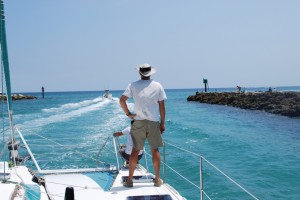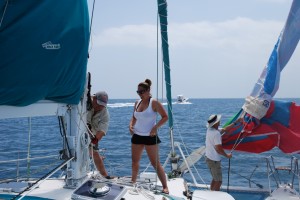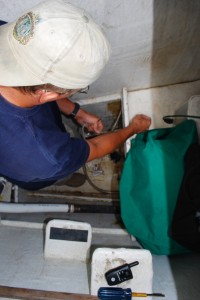It has been an eventful few days. We said good-bye to Tiffany’s parents on Saturday morning and headed out the Boca Raton Inlet. There were many recreational boaters and some shallow shoals to contend with, but soon we were out of the channel. The winds were from the north (they are typically from the south this time of year—the same direction that we are trying to head), so we thought we might be able to cover some ground early on using our nice spinnaker.
We settled for using the mainsail and genoa and headed offshore. The seas were not too intense, but having been on land for a few weeks, the motion was enough to make us all a little queasy. Moreover, the southerly current pushing against us from the Gulf Stream was amazingly strong. Wes kept track of our average speed early on in his watch and informed us that at the rate we were going (around 0.5 knots per hour), we would reach Miami in a week or so! This was obviously frustrating, but we persisted at adjusting the sails to maximize our speed and ended up plugging along at two to three knots for the remainder of the day.
I took my first solo watch Saturday evening. I had requested my own so that I could experience the independence and freedom of it, and let’s just say that my expectations were met. I felt pretty confident at the helm after reading It’s Your Boat, Too by Suzanne Giesemann, a former Navy commander. As you might guess from the title, the thesis of her book is that women should take a more proactive, participatory role if they want to fully enjoy boating as their partners do. For me, this reinforced what we had already planned in terms of my role on Pura Vida, but I learned quite a bit from the section on the basics of sailing—navigation, communications, weather, boat handling and docking, etc. and felt that I was up for the challenge of taking the helm (with Dallas nearby of course).
Speaking of challenges, Suzanne posits in her book that women often are spectators on their boats because they are fearful of looking like they don’t know what they are doing. She points out that men start out as beginners, too, but their excitement about the challenge and adventure involved in boating overcomes their desire to save face. In my case, I have learned to love a good challenge, and moreover, to laugh at myself in the process. It’s a good thing, too, because I’ve been making a lot of mistakes! My first real mistake at the helm didn’t happen until midday on Sunday, when every man and his dog were fishing off the coast of Miami. Apparently I got too close to one of the small fishing boats for the captain’s liking, leading him to throw an empty can of beer in my direction. Oops!
By monitoring channel 16 on the VHF radio (as the Coast Guard requires), we learned that there were many utterances of “oops” (or perhaps another word) at sea on Sunday. There was a sailboat that hit a fishing boat pretty close to us such that we could hear the initial “may-day” call to the Coast Guard. There was also a woman who was very upset about her dog going overboard, but the Coast Guard put out an alert, and the dog was found soon after. Wes and Tiffany heard another distress call in which a sailboat was dismasted during a collision with a motor vessel and the two remained entangled waiting for the Coast Guard to arrive. The most serious alerts from the Coast Guard were about a 17 foot fishing boat that was overdue at its destination. We later learned that the boat had been found, but the man and child that had been on it had not. Needless to say, the Coast Guard was busy over the weekend, and we were reminded of how important it is to sail safely. In fact, I am pleased to report that Dallas is wearing his inflatable life jacket at the helm as we speak.
The only time that I felt nervous while at the helm (and woke Dallas up repeatedly) was on Sunday night when we were tacking through the shallow reefs at the top of the Florida Keys. For those of you who are not sailors, tacking is necessary when you are trying to go in the direction from which the wind is coming, because it is not possible to sail directly into the wind. Tacking involves sailing a zig-zag course in which you sail at an angle to the wind, switch directions, and sail from the opposite angle (see diagram below). Naturally, it is slower than sailing in a straight line, and when you also take into account the contrary current pushing us backwards, it no surprise that we fell short of our goal to arrive in Key West by Monday night. The good news, however, is that rather than sailing all night through the cold front with 20-30 knots of wind on the nose and 6-8 foot seas, we enjoyed an evening at anchor in Key Largo (and only got up once in the night to make sure the anchor wasn’t dragging!).
For the sailors out there, we have a 25kg Rocna anchor that we’e been very pleased with so far, as it’s always set the first time and held, but that wasn’t the case in Key Largo. Our first three attempts to set the anchor were in a grassy area near the entrance of the Key Largo channel that all resulted in the anchor filling with grass and soft sand and dragging along the bottom. After three unsuccessful attempts we considered trying our CQR, but decided instead to move to less grassy area where there were a number of other boats anchored. This time the anchor set on the first attempt and held as we swung with the backing winds from the front.
A good night’s sleep was just what the doctor ordered, and we woke up raring to get back out there. We decided to stay inside the reefs where the seas are calmer and there is less current. Initially, the seas created a condition of, as Dave on www.maxingout.com put it, “no-bruising cruising”. We took full advantage of it— Wes did some morning exercises while at the helm, Tiffany caught up on her reading, I cleaned and started blogging, and Dallas started in on his continual to-do list of repairs, only to discover 45 gallons of sea water in the forward port bilge! While this sounds like a serious problem, it took no more than a couple of hours for Wes and Dallas to empty the bilge and for Dallas, with the help of his tool-getting assistant (moi) standing by on the family-band radio, to reconnect the bilge pump hose that had become dislodged, plug up the hole from the broken holding tank vent through-hull, solder new bilge pump connections, and check to make sure the switch and pump were working.
Now the winds have picked up, and we are getting some violent motion created by the pounding of the bridgedeck of the boat against the waves as we beat into the wind (i.e., sail as close to the wind as possible). To me, it’s as if the boat is doing belly flops! However, there has been no “feeding the fish” on this, our second multi-day nearshore/offshore run. It seems that we are in fact getting our sea-legs.
Well, that’s all for now. Stay tuned for more about our adaptation to sea life, including taking showers using a bug-sprayer!






